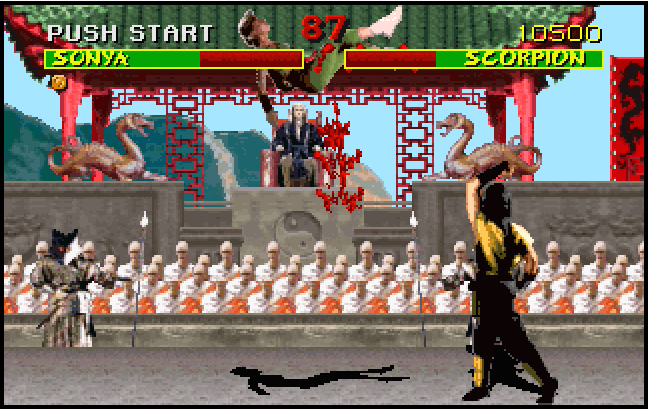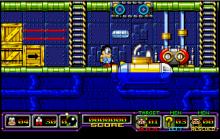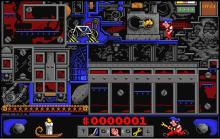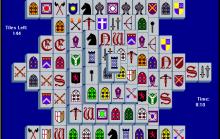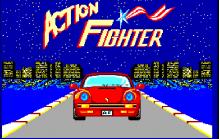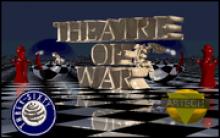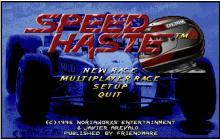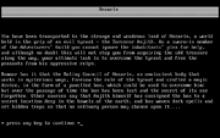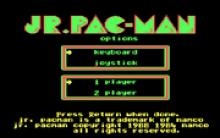Mortal Kombat
Press Keyboard right side: Alt+Enter keys to switch to full screen game play, and Alt+Enter keys to return.
How to play Mortal Kombat
Johnny Cage
- Green Bolt: B, F, LP
- Shadow Kick: B, F, LK
- Ball Breaker: BL + LP
- Fatality: F, F, F, HP (close)
Kano
- Spin Attack: F, D, B, Up, F, ...
- Knife Throw: Hold BL, B, F
- Fatality: B, D, F, LP (close) – PC, A, SN, XB, PS2
- Fatality: B, B, B, LP (close) – SG
Raiden
- Teleport: D, Up
- Lightning: D, F, LP
- Torpedo: B, B, F
- Fatality: F, B, B, B, HP (close)
Liu Kang
- Fireball: F, F, HP
- Flying Kick: F, F, HK
- Fatality: F, D, B, Up, F, ...
Scorpion
- Spear: B, B, LP
- Teleport: D, B, HP
- Fatality: Hold BL, Up, Up (½ screen)
Sub-Zero
- Ice Freeze: D, F, LP
- Slide: Hold B + LP + LK + BL – PC, A, SN, XB, PS2
- Slide: Hold B, LK + HK – SG
- Fatality: F, D, F, HP (close)
Sonya
- Ring Toss: LP, B, LP – A (Revision 5)
- Ring Toss: B, B, LP – PC-DOS
- Ring Toss: B, LP, B, LP – All others
- Leg Grab: D + BL + LP + LK
- Square Flight: F, B, HP
- Fatality: F, F, B, B, BL
Mortal Kombat Description
When Mortal Kombat hit arcades in 1992, it didn’t just join the fighting game scene — it changed it forever. Developed by Midway Games, this dark, gritty one-on-one fighter stood out in a sea of colorful competitors like Street Fighter II. It was the game parents warned you about, the one kids whispered about in school, and the one that introduced the world to “Fatalities” — finishing moves so violent they sparked debates in congress.
Today, more than 30 years later, Mortal Kombat (1992) is remembered not just for its shock value, but for its sharp gameplay, memorable characters, and influence on everything from modern fighting games to film adaptations. This is the definitive guide to the arcade classic that started it all.
- Released in 1992 by Midway Games for arcades and later for PC and consoles
- Featured digitized actors, a unique block button, and infamous Fatalities
- Seven playable fighters, each with signature special moves
- End goal: defeat sub-boss Goro and final boss Shang Tsung
- Still playable via emulators, compilations, and online arcade platforms
The Birth of Mortal Kombat
By the early ’90s, fighting games were everywhere. But Midway wanted something edgier — a game that looked more real, hit harder, and stuck in players’ minds long after they left the arcade. The result was Mortal Kombat, directed by Ed Boon and John Tobias.

Instead of animated sprites, the team used digitized video of real actors, creating an uncanny realism for the time. Add to that a darker tone, over-the-top violence, and a roster of martial arts warriors with supernatural abilities, and Mortal Kombat became an instant hit — and a lightning rod for controversy.
Gameplay That Broke the Mold
At its core, Mortal Kombat was a best-of-three-round fighting game. Each match pitted two fighters against each other, with the first to drain their opponent’s health bar twice declared the winner. But unlike other fighters of the era, every character in the game had identical basic attacks — the difference came from their special moves and Fatalities.
The arcade controls were distinctive:
- An eight-way joystick for movement, crouching, and jumping
- Four attack buttons for high and low punches and kicks
- A dedicated block button in the center, making defense more deliberate and strategic
This block mechanic set it apart from Street Fighter II, where holding back was the only way to guard.
The Power of Special Moves and Fatalities
Special moves in Mortal Kombat were executed through specific joystick and button combinations. Mastering these was key to success. Scorpion’s spear attack could pull enemies into striking range. Sub-Zero’s ice blast froze opponents, leaving them vulnerable. Raiden could teleport behind his foe or send them flying with a lightning-charged shoulder tackle.
Then came the game’s signature feature — Fatalities. When an opponent’s health was gone, the announcer called out “Finish Him!” and players had a brief window to input a special sequence for a gruesome ending. These moments were as much about bragging rights as they were about winning.
Some of the most famous included:
Liu Kang: The Kung Fu Champion

Liu Kang, a master of martial arts, is a central character in Mortal Kombat lore. His fiery personality matches his dragon-themed attacks, making him a formidable fighter.
Noob Saibot: The Shadowy Enigma

Noob Saibot, the shadowy ninja, embodies mystery and darkness. His enigmatic presence adds a layer of intrigue to the game.
Kitana and Mileena: Twin Terrors

Kitana and Mileena, the twin sisters, bring their own unique styles to the battlefield. Kitana wields razor-sharp fans, while Mileena's deadly sais make her a formidable adversary.
Johnny Cage: The Hollywood Star

Johnny Cage, the charismatic movie star turned warrior, adds a touch of humor to Mortal Kombat with his flashy moves and witty one-liners.
Kung Lao: The Razor-Edged Hat Wielder

Kung Lao's razor-edged hat is his trademark weapon. His acrobatic skills and martial arts prowess make him a memorable character in the series.
Raiden: The Thunder God

Raiden, the god of thunder, assumes the role of safeguarding Earthrealm. His electric attacks and wisdom make him a pivotal figure in the Mortal Kombat universe.
Sonya Blade: The Special Forces Officer

Sonya Blade, a dedicated special forces officer, brings a sense of duty and determination to the roster of characters. Her military training is evident in her combat style.
Shang Tsung: The Shapeshifter

Shang Tsung's ability to shapeshift and steal opponents' powers makes him one of the most intriguing villains in Mortal Kombat.
Scorpion: The Vengeful Specter

Scorpion, a vengeful specter, is known for his fiery attacks and unrelenting pursuit of those who wronged him. His iconic catchphrase "Get over here!" strikes fear into the hearts of his opponents.
Sub Zero: The Cryomancer

Sub Zero, the cryomancer, freezes his enemies with deadly precision. His rivalry with Scorpion is legendary, adding depth to the game's storyline.
Baraka: The Blade-Wielding Horror

Baraka, a fearsome warrior with blade-filled arms, strikes terror into his foes with his gruesome attacks and menacing appearance.
Goro: The Four-Armed Behemoth

Goro, a four-armed behemoth, dominates the battlefield with his immense strength and intimidating presence.
Miss the input, and you’d just throw a basic punch — an anticlimax every arcade crowd loved to mock.
Meet the Fighters
The original lineup included seven playable characters, each with a distinct look and personality:
- Liu Kang – The Shaolin monk with blazing kicks, inspired by Bruce Lee.
- Johnny Cage – Hollywood action star whose shadow kick was as flashy as his sunglasses.
- Kano – A mercenary with a laser eye and a deadly knife throw.
- Raiden – Thunder god who could teleport and unleash electric fury.
- Scorpion – A vengeful ninja with his famous spear attack (“Get over here!”).
- Sub-Zero – Assassin with the power to freeze his foes in place.
- Sonya Blade – Special Forces fighter with leg grabs and energy ring projectiles.
Each character’s differences came entirely from their special moves and Fatalities, which encouraged players to pick a favorite and master them.
How to Win Like an Arcade Champion
Success in Mortal Kombat wasn’t about button mashing. It was about knowing when to attack, when to block, and when to bait your opponent into making a mistake. Here are a few battle-tested tips from arcade veterans:
- Use the block button — it’s one of the game’s defining features, and many beginners ignore it.
- Control the spacing — don’t let yourself get trapped in a corner where escape is harder.
- Master jump kicks — they’re a safe way to approach without eating a counterattack.
- Learn your Fatalities — nothing ends a fight with more style or psychological damage.
- Against Goro — stay mobile, punish his slow recovery after leaping attacks.
The original game didn’t have a story mode, but there was still an end goal: survive the tournament ladder, defeat Goro, and face Shang Tsung for the title.
Mortal Kombat vs Street Fighter II

In the arcades, comparisons were inevitable. Street Fighter II dominated the market before Mortal Kombat arrived, but the two had very different styles:
|
Feature |
Mortal Kombat (1992) |
Street Fighter II (1991) |
|
Graphics |
Digitized actors |
Hand-drawn sprites |
|
Special Feature |
Fatalities |
Combo system |
|
Blocking |
Dedicated button |
Hold back |
|
Characters |
7 |
8 |
|
Tone |
Dark fantasy, violent |
Bright, colorful martial arts |
Mortal Kombat thrived by embracing its differences. It was grittier, more grounded visually, and more shocking — perfect for grabbing arcade attention.
From Arcade to Everything Else
The success of the arcade release led to ports on consoles, PCs, and handheld systems. Some versions were censored — most famously, Nintendo’s SNES release replaced blood with “sweat” — but the Sega Genesis version kept the gore with a cheat code, helping it outsell the competition.
Over time, the franchise evolved through multiple sequels and reboots:
- Mortal Kombat (2011) returned to the classic 2D fighting style with modern visuals.
- Mortal Kombat X (2015) introduced brutal variations of Fatalities and a faster pace.
- Mortal Kombat 11 (2019) added cinematic story modes and deep customization.
- Mortal Kombat 1 (2023) rebooted the entire timeline, adding a “Kameo” assist system.
And of course, there were movies. The 1995 live-action film became a cult favorite, while the 2021 reboot delivered R-rated fights closer to the games’ tone.
Common Mistakes to Avoid
- Button mashing — you’ll get punished by anyone who knows spacing and timing.
- Ignoring the block button — it’s one of the most important mechanics.
- Forgetting Fatality practice — nothing feels worse than missing it in front of an arcade crowd.
Mortal Kombat is a fighting game in which players battle opponents in one-on-one matches. The fighter that completely drains the opponent's health bar first wins the round, and the first to win two rounds wins the match. Each round is timed; if both fighters still have health remaining when time runs out, the one with more health wins the round.
Players select one of seven characters. Whereas other fighting games had characters with considerable differences in speed, height, attacks, strength, jumping heights and distances, the playable characters in Mortal Kombat are virtually identical to one another with only minimal differences in their moves' range and speed. The game also distinguished itself from other fighting games of the time with its unique control scheme.
The controls consist of five buttons arranged in an "X" pattern: four buttons for high and low punches and kicks with a block button at the center, as well as an eight-way joystick. Attacks can vary depending on the player's distance from the opponent. All player characters have a shared set of attacks performed by holding the joystick in various directions, such as leg sweep and an uppercut; the latter attack knocks the enemy high into the air and causes a large amount of damage.
Cheats/Hints/Walkthroughs for Mortal Kombat
Press F10 to go to the options screen where you can define controls etc, while in this menu hold shift and type D I P this will open up some switches that change some hidden options in the game.
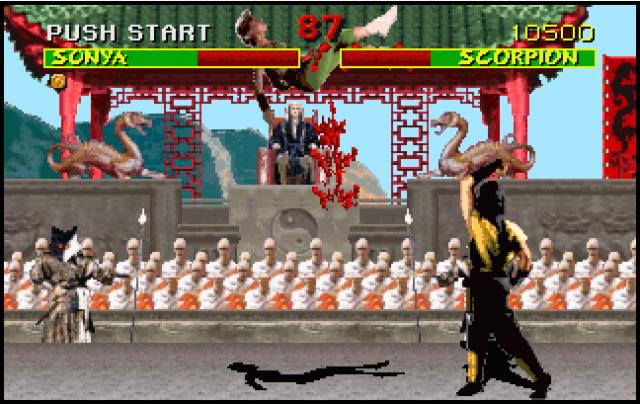
Mortal Kombat - additional information







